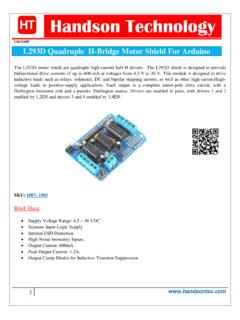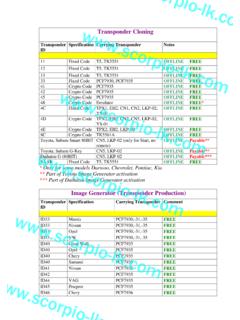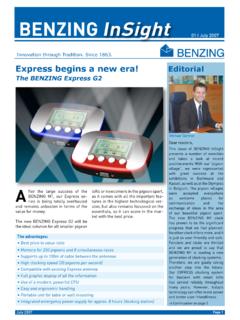Transcription of Immobilizer and RKE System Design - HandsOn Tech
1 Immo-RKE- System - Design Version 4 Philips SemiconductorsImmobilizer and RKES ystem DesignVersion 4 Immo-RKE- System - Design Version 4 Philips SemiconductorsPart 1: Immobilizer DesignContent1 Introduction2 Immobilizer antenna design3 ABIC Design and optimization4 System verificationNote:At the beginning of every chapter of this presentation an overviewabout related documents, software and development tools is associated product specifications are not explicitely Version 4 Philips SemiconductorsIntroduction System configuration Basics of communication1 Related Documents, Software and Tools: Application Note AN99075: Designing RF-Identification Basestations with theAdvanced Basestation IC PCF7991. User Manual and Software HSIS/UM9708: Control Software Library for PDF7991 ATand PCF7936AS. User Manual and Tool: Transponder Evaluation and Development Kit (TED-Kit) Version 4 Philips SemiconductorsSystem Configuration (Principle)ABICABICI/OFunctionsI/OFuncti onsInterfaceDriversInterfaceDriversAnten naRaCaLaTx1 RxTx2 Inputs,OutputsVDC,GNDBus-systemVoltageRe gulatorVoltageRegulatorHITAG/STARCHITAG/ STARCP owerDataMicrocontrollerTransponderBasest ationRxImmo-RKE- System - Design Version 4 Philips SemiconductorsIntroduction System configuration Basics of communication1 Immo-RKE- System - Design Version 4 Philips SemiconductorsPrinciple of Data Transmission from TransponderdataVtIbVbItdemodulatordataen ergy6 Vtap pointImmo-RKE- System - Design Version 4 Philips SemiconductorsData Transmission from the TransponderDataCDPM anchesterData rates for Manchester/CDP (HITAG2).
2 4 kbit/sTrans-ponderRWDRLImmo-RKE- System -D esign Version 4 Philips SemiconductorsPrinciple of Data Transmission to TransponderVtIbVbItdemodulatordataenergy data6 VVImmo-RKE- System - Design Version 4 Philips SemiconductorsData Transmission to the TransponderDataCodingTimingBasestationAn tenna SignalDrivers onDrivers offDuration of : T0 TLOG1 Version 4 Philips SemiconductorsImmobilizer antenna Design Physical parameters of antennas Typical Design requirements Electrical Design rules Mechanical antenna design2 Related Documents, Software and Tools: Application Note AN99075: Designing RF-Identification Basestations with theAdvanced Basestation IC PCF7991. Laboratory Report: Questions to the ABIC (PCF7991).Immo-RKE- System - Design Version 4 Philips SemiconductorsSeries Resonant Circuit (1) damping factor: time constant: quality factor: voltages (magnitude):RCLV0 VCVLVRI = RL2 =1 QfBLRf== = 000 0C0L0 RVQVVQVVV = ==Immo-RKE- System - Design Version 4 Philips SemiconductorsSeries Resonant Circuit (2) [kHz] ->abs(Y))/Ymax -> f=Bf0capacitiveinductive1001101201301401 50-100-50050100f[kHz] ->phase(Z)[ ]->f0capacitiveinductiveImmo-RKE- System - Design Version 4 Philips SemiconductorsEffective Series Parameter of the AntennaCwRohmLRsXeff, SPhysical circuit and serial equivalent circuit of a coil at 125 KHz.
3 RRLCRCLCRLCSohmWohmWW2 Wohm= + 112 XRCLCLCRLCeff,S2 WWW2 Wohmohm= + + 112 QXRLeff,SS=Rohmohm's resistance of the antenna [ ]Linductance of the antenna [H]CWinterwinding capacitance of the antenna [F]RSeffective series resistance of the antenna [ ]Xeff S,effective series reactance of the antenna [ ]QLquality factor of the antennaPractical approach: Measurementof the effective series parameterImmo-RKE- System - Design Version 4 Philips SemiconductorsAntenna Quality Factor Definition: QL=XL/RL=fRes/B Determines transient and decay times of the antenna signal write pulses energy content of the field transmission range Influenced by losses due to eddy currents in metal in the vicinity of antenna thickness of antenna wire permeability of the core losses due to energy absorption by transponderImmo-RKE- System - Design Version 4 Philips SemiconductorsResonant frequency Definition: Particular value is influenced by: Production tolerances of the antenna components Changes of the component values due to temperature influence Aging of the antenna components High damping factor (low Q) reduces effective resonantfrequency.
4 CL21200 == f220'0 =Immo-RKE- System - Design Version 4 Philips SemiconductorsCoupling factorRWDT ranspondercoilkRWDA ntennakTransponderenergydataL2L1C2R2R1C1 k (coupling factor) depends on the- amount and- direction of the magnetic fieldImmo-RKE- System - Design Version 4 Philips SemiconductorsCoupling factor Describes how many field lines of the basestation antenna arecaptured by the transponder antenna Pure geometric parameter and independent from the antennainductances Relation between coupling factor and System performance isstronger than linear Depends on the mechanical antenna Design , that is the form and size of the basestation and transponderantennas their placement relative to each other the materials inside or close to the coils Since the coupling factor is hard to calculate or to find bysimulations, the parameter should be measuredImmo-RKE- System - Design Version 4 Philips SemiconductorsCoupling factor measurementTranspondercoil (L2)BasestationAntenna (L1)kV1V2 Frequencygenerator(125kHzSine-wave)Oscil loscopeConditions.
5 Immo-key is placed in home position transponder is replaced by atransponder coil (molded coil) all material near the antenna whichhas influence on the coupling ( ) must be included for thismeasurement Attention: V2 has high impedance,proper probe calibration low-capacitive =LLVVkImmo-RKE- System - Design Version 4 Philips SemiconductorsImmobilizer antenna Design Physical parameters of antennas Typical Design requirements Electrical Design rules Mechanical antenna design2 Immo-RKE- System - Design Version 4 Philips SemiconductorsTypical Design requirements Energy supply for transponder function and possible battery charging( with STARC) Specification of the data communication between basestation andtransponder: modulated voltage received from the transponder must besufficient over a wide tolerance range write pulse specification has to be met Tolerances specifications of the antenna elements EMC requirements: susceptibility radiation Communication distanceImmo-RKE- System - Design Version 4 Philips SemiconductorsTypical System parameters Basestation antenna parameters: Quality factor range:5 -15 Antenna inductance range:350 -1200 H Transponder antenna parameters: Quality factor (typ.)
6 :35 Antenna inductance (typ.) mH Coupling factor - 20 %Immo-RKE- System - Design Version 4 Philips SemiconductorsImmobilizer antenna Design Physical parameters of antennas Typical Design requirements Electrical Design rules Mechanical antenna design2 Immo-RKE- System - Design Version 4 Philips Semiconductors Due to the variety of different requirements and restrictions, the immobilizerantenna Design is rather an iterative process To optimize the System and to meet all requirements, System simulations shouldbe applied during the Design Following, some basic Design rules are given, to support the optimizationprocessElectrical Design rules (1): General RemarksImmo-RKE- System - Design Version 4 Philips Semiconductors For designing a transponder antenna for a normal application of HITAG2+ orSTARC1,L= , Q=35, as used in the HITAG2 transponder is a goodstarting value. Larger transponder inductances increase the induced voltage at transponderside, however they reduce the modulation voltage seen at the basestation.
7 Thatmeans with larger inductances the transponder will be kept running in largerdistances, however the distance where the reader stops to demodulate thesignal coming back, because of noise, sensitivity limitations and EMI will bereduced. Smaller inductances lead to the opposite effect in both cases. Finding theoptimum compromise is only possible employing System simulations. Howeverthe optimization curve is very flat. Therefore a change from 2,3mH has only a minor effect. From the actual experience we d propose to Design rules (2): Transponder antennaImmo-RKE- System - Design Version 4 Philips Semiconductors A smaller Q will reduce the maximum operating distance, however normally hasno high impact in the key home position. If a STARC1- System is designed for battery charging, smaller inductances shallbe applied to allow higher currents (around 1mH). Optimization has to be doneby simulations. The models for STARC2 are still under development.
8 At the moment we proposealso as a starting value for optimization of the transponder inductance. The size and volume of the ferrite core influences the coupling factor. Highervolumes lead to higher coupling, however this effect is only proportional to the3rd root of the Design rules (3): Transponder antennaImmo-RKE- System - Design Version 4 Philips SemiconductorsImmobilizer antenna Design Physical parameters of antennas Typical Design requirements Electrical Design rules Mechanical antenna design2 Immo-RKE- System - Design Version 4 Philips Semiconductorsmetal lockbarrelmetal lockbarrelTransponderTransponderPlastic spacerPlasticspacerKeyKeyAntennacoilAnte nnacoildash boardThe upper designexample normally resultsin higher coupling factorsMechanical Design : ConfigurationsImmo-RKE- System - Design Version 4 Philips Semiconductors Keep some distance between metal lock barrel and antenna coilby a plastic spacer part not to dissipate too much field energy inform of eddy currents into the metal.
9 Place the transponder in axial direction as close to the antennaas possible or even inside. The distance of the transponder in radial direction from the lockbarrel middle axis must be smaller than the inner coil windingradius. Inside the key, the transponder should be placed as far aspossible from the key metal parts but as close as possibletowards the antenna Design Rules (1)Immo-RKE- System - Design Version 4 Philips Semiconductors Metal parts of the dash board should be as far as possible awayfrom the antenna. The coupling factor should be optimized by practical experimentswith different coils, coil positions, transponder positions andtransponder angles relative to the middle axis by powering theantenna coil with a 125kHz sine frequency generator andmeasuring the induced voltage in a molded coil in transponderposition before finishing the lock Design . Optimization byanalytical calculations is hardly Design Rules (2)Immo-RKE- System - Design Version 4 Philips Semiconductorsmetal lockbarrelTransponder too far from Antenna too close to metalpart of keyKeyAntenna coil too far from transponder no space between metal an coilBad Mechanical Design ExampleImmo-RKE- System - Design Version 4 Philips Semiconductors The mechanical stability of the ferrite coil of the transponder antenna, alsorelatedtoit s packaging and the way the part is soldered to the PCB, is veryimportant.
10 This issue should be addressed by fall tests with coils soldered to thefinal PCB. The temperature and humidity drift of the inductance is a very important issue aswell as a small manufacturing tolerance. The overall tolerance should be in the 3% range, at least for systems with weak coupling. If water can enter the key housing and short the coil or the interconnection to thetransponder IC, the System will fail. Therefore, water protection by molding,lacquering or a water resistant sealed key is RequirementsImmo-RKE- System - Design Version 4 Philips SemiconductorsABIC basestation Design and optimization Design and adaptation of the resonantcircuit to the ABIC Implementation of the AST algorithm Configuration of the ABIC Electrical verification and debugging3 Related Documents, Software and Tools: Application Note AN99075: Designing RF-Identification Basestations with theAdvanced Basestation IC PCF7991. Laboratory Report: Proposal for a Circuit Design and PCB-Layout for the PCF7991(ABIC) User Manual and Tool: Transponder Evaluation and Development Kit (TED-Kit) Version 4 Philips SemiconductorsBasic specifications for ABIC basedsystems ABIC:- maximum antenna current:Imax,p=200mAp(Burst mode: 400 mAp)- output voltage:Vout=5V*4/ = maximum Rx-pin-input voltage:VRx,p= basestation inductance value range: L = 350.










